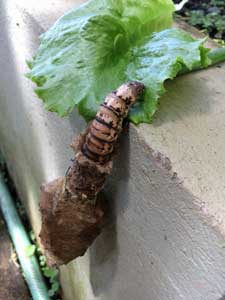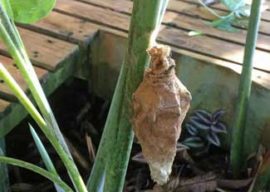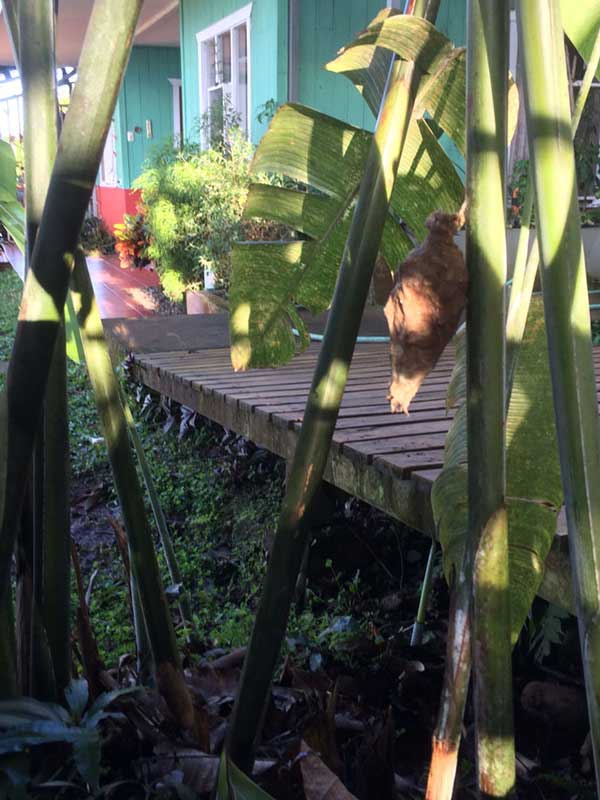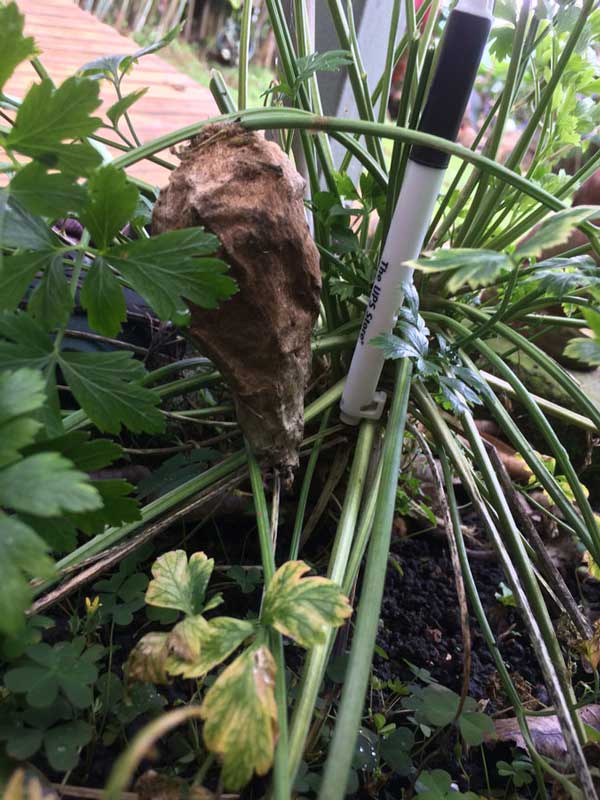I almost stepped on it, thinking it was a dried leaf.
Glancing down I noticed small bits of green that seemed to be attached to whatever it was. Measuring about four inches long, conical in shape with several green short stems attached to one end of the cocoon like structure, I thought of a cocoon. Curious, I picked it up to examine it more closely and laid it on the concrete edge of my vegetable planter. I thought that whatever it was, it had washed down out of the mango tree above and would likely be safe while I did some research on it. At first I wasn’t sure it was alive – but after awhile, I noticed that a caterpillar like creature extended itself from one end of the structure. So I thought perhaps it was a caterpillar with its cocoon attached. I’d have to do some research.
Online I discovered that something called the Bagworm or Case Moth or Case Bearer were likely common names my Costa Rican yard visitor. It was likely a member of one of the two scientific sub-families of the Family, Psychidae – and the larva of a kind of moth/butterfly. They are all case-bearers meaning that they buld small protective cases in which they can hide.
After posting the photos on Facebook, a friend suggested I confirm with an insect specialist in Costa Rica, Daniel Janzen. He replied to the photos I sent him with an assurance that my identification was correct. I went on to study the creature some more while I tempted him with lettuce from my garden.
 The Bagworm or Case Moth builds a bag of silk in their larval stages – that grows as they grow and is often decorated with plant materials to keep them hidden. That explained the green pieces of stem at one end. Whenever they are eating or not bothered, the caterpillar extends itself out. It retreats readily when frightened. It can attach itself to a host plant or a structure with a really strong substance that it exudes. And there was more. It is only the male that eventually leaves the case, never to return. During its worm stage, the Bagworm adds material to the front of the case that allows it to grow. When it is finally satiated with leaves, the caterpillar secures its case and pupates. The adult female, which is wingless, either emerges from the case long enough for breeding or remains in the case while the male extends his abdomen into the female’s case to breed. Then, the females lay their eggs in their case and die. Fascinating.
The Bagworm or Case Moth builds a bag of silk in their larval stages – that grows as they grow and is often decorated with plant materials to keep them hidden. That explained the green pieces of stem at one end. Whenever they are eating or not bothered, the caterpillar extends itself out. It retreats readily when frightened. It can attach itself to a host plant or a structure with a really strong substance that it exudes. And there was more. It is only the male that eventually leaves the case, never to return. During its worm stage, the Bagworm adds material to the front of the case that allows it to grow. When it is finally satiated with leaves, the caterpillar secures its case and pupates. The adult female, which is wingless, either emerges from the case long enough for breeding or remains in the case while the male extends his abdomen into the female’s case to breed. Then, the females lay their eggs in their case and die. Fascinating.
A 6″ ball point pen shows its relative size.
My Case Moth was now firmly attached to the parsley and seemed to be enjoying the variety. Even though it was the rainy season, I kept checking on my visitor for the next few days.
Case Moth on Heliconia plant with my house in the background.
On Day 3 it was missing. I looked and looked, finally finding it a few feet away from the garden on a stem of the heliconia plant. Slowly it inched upward,
The last time I saw the Case Moth, it was busy eating a Heliconia leaf which also sheltered it from some of the rain. I assume that it moved on up through the plant and perhaps back up into the mango tree.
Definitely a pleasant visitor and one I hope again to see. And there is a good chance I will. I discovered in my research that the case moth’s caterpillar stage may last up to two years.




